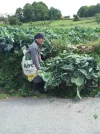I REFUSE to believe that you eat caldo gallego made with napa cabbage! Come on, Pinguirigrino, what is your secret home recipe?! Are you just trying a diversionary tactic to avoid sharing the secret?

I know I can find a million recipes on google, but people can also find the answers to most of the questions they post here on google, and we answer those questions anyway with our personal experience informing the answer. Personal favorites, vegetarian or not, would be welcome. I make caldo gallego a lot every winter, but I would love to compare ingredients to see what kind of tweeks might make it even better.
p.s. I would be happy to post my own recipe if anyone is interested.
























